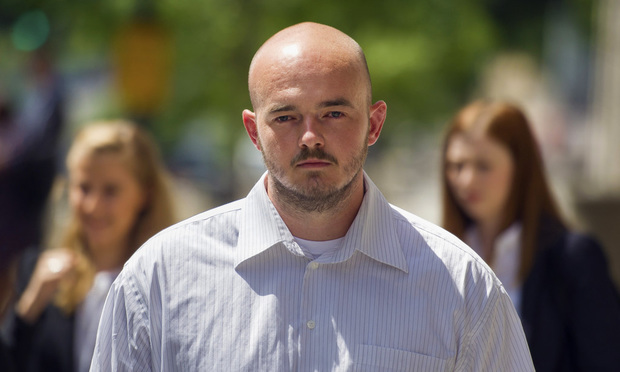Daily Dicta: Williams & Connolly Blasts Feds for Withholding Major Exculpatory Evidence (Again) in Blockbuster Case
"Enough is enough," the Williams & Connolly team wrote in a motion for a new trial. "Mr. Slatten's service to this country has been repaid with more than a decade of flawed legal proceedings caused by repeated government transgressions."
December 04, 2019 at 12:50 AM
7 minute read
 FILE – In this June 11, 2014 file photo, former Blackwater Worldwide guard Nicholas Slatten leaves federal court in Washington, after the start of his first-degree murder trial. A federal judge has sentenced a former Blackwater security contractor to life in prison for his role in the 2007 shooting of unarmed civilians in Iraq. (AP Photo/Cliff Owen)
FILE – In this June 11, 2014 file photo, former Blackwater Worldwide guard Nicholas Slatten leaves federal court in Washington, after the start of his first-degree murder trial. A federal judge has sentenced a former Blackwater security contractor to life in prison for his role in the 2007 shooting of unarmed civilians in Iraq. (AP Photo/Cliff Owen)
Ex-Blackwater security contractor Nicholas Slatten has already been tried three times for first-degree murder—and made three trips to the U.S. Court of Appeals for the D.C. Circuit.
Get ready for number four.
Slatten's pro bono legal team from Williams & Connolly just uncovered major new evidence that undercuts the government's case against Slatten in connection with a 2007 massacre in Baghdad that left 14 civilians dead—evidence that DOJ prosecutors failed to turn over to the defense.
In a motion filed Monday, firm lawyers Dane Butswinkas, Barry Simon, Tobin Romero, Simon Latcovich, Amy Mason Saharia and Krystal Commons asked U.S. District Senior Judge Royce Lamberth for (at minimum) yet another new trial.
"Enough is enough. Mr. Slatten's service to this country has been repaid with more than a decade of flawed legal proceedings caused by repeated government transgressions," they wrote. "He has served more than five years in a prison for a shooting that he did not commit, based on false testimony and argument, all in violation of the Due Process Clause."
 That Slatten is represented by Williams & Connolly is fitting. Eleven years ago, the firm defended the late Alaska Sen. Ted Stevens in his corruption trial, where DOJ prosecutors also failed to turn over key exculpatory evidence.
That Slatten is represented by Williams & Connolly is fitting. Eleven years ago, the firm defended the late Alaska Sen. Ted Stevens in his corruption trial, where DOJ prosecutors also failed to turn over key exculpatory evidence.
In the wake of the Stevens debacle, the department supposedly revamped its procedures for Brady rule compliance. On April 8, 2009, the day after the case against Stevens was dismissed, then-Attorney General Eric Holder offered some aspirational words: "Your job as assistant U.S. attorneys is not to convict people," Holder said. "Your job is not to win cases. Your job is to do justice."
But in the Slatten case, prosecutors seem to have fallen well short of these lofty goals.
Slatten was charged with causing the death of Ahmed Haithem Ahmed Al-Rubia'y, a medical student who was driving a white Kia in a traffic circle in Baghdad's Nisur Square on September 16, 2007.
Slatten was part of Blackwater team Raven 23, which had been deployed after a car bomb exploded outside a venue in Baghdad where a U.S. diplomat was located. Charged with helping facilitate the diplomat's return to the Green Zone, 19 Blackwater guards in four armored vehicles positioned themselves in the traffic circle.
As the Kia approached the convoy, shots were fired—then more shots, rounds of machine gun fire, grenades. In the end, 14 civilians died and 31 were wounded.
It was a tragic incident with significant international repercussions. But was Slatten to blame for firing the first shot that killed the Kia driver and started it all?
He insists he is innocent—and another Blackwater guard, Paul Slough, later confessed on multiple occasions to the shooting, according to the defense.
At Slatten's first trial (where he was represented by Tom Connolly of Harris, Wiltshire & Grannis), he was convicted, but the verdict was overturned on appeal. Williams & Connolly came on board for his second trial, which ended in a hung jury.
At his third trial, Slatten was convicted. In August, the 35-year-old Tennessee native was sentenced to life in prison.
Key to the prosecution was casting Slatten as a violent hothead, someone who "either takes unprovoked shots where no threat is present, or he urges other people to do that," DOJ lawyers said.
At trial, the feds relied on testimony from two cooperating witnesses, fellow Blackwater guards Matthew Murphy and Jeremy Ridgeway.
The pair testified about Slatten's participation in a downed aircraft rescue team, or DART, mission that took place about one week before the Nisur Square incident. The point was to show that Slatten was spoiling for a fight.
"In its attempt to prove the necessary intent for a shooting that occurred in a war zone and to sell the jury on the implausible story that Mr. Slatten shot for no reason the driver of a white Kia (the first person shot during the incident), the government argued that Mr. Slatten had previously fired his weapon first in an attempt to start a firefight," the Williams & Connolly team wrote in the motion filed Monday.
"In the government's own words," the defense team continued, "the evidence regarding the DART incident showed that Mr. Slatten 'indiscriminate[ly]' shot his weapon 'without regard for who might be struck by the rounds,' which the government claimed was 'powerful evidence' of Mr. Slatten's state of mind at the time of the charged incident."
Specifically, the government argued Slatten "fired at a person in the building, who was not a threat, for the express purpose of starting a firefight," and that Slatten brought "lethal force to bear when it was not authorized, when there was no provocation."
Which hey—does seem like exactly the kind of behavior you'd expect from a person who'd go on to spark the Nisur Square massacre a week later.
But here's what the government neglected to mention: that its two star witnesses, Murphy and Ridgeway, initially gave very different accounts of the DART mission.
In their original sworn statements dated September 11, 2007—the day after the DART incident—Murphy and Ridgeway "contradict the government's narrative on every meaningful point," the Williams & Connolly lawyers wrote.
For example, who fired first in the DART incident? Was it Army soldiers or Slatten? At trial, Murphy said Slatten fired first. But in 2007, he said that "Army assets were observed in a firefight" shortly after they arrived.
Who incorrectly claimed there was a deadly threat in the building? At trial, Murphy said it was Slatten. But at the time, Murphy said an Army captain told them he "believed several of the armed subjects made it through to the buildings."
The defense got wind of the undisclosed docs in August after a third party (who is not being publicly identified) tipped them off to a State Department presentation on the DART event.
The presentation—which included real-time accounts from Army participants—documented that Army forces were under fire before the Blackwater team arrived at the site. This flatly contradicted the prosecution's story that Slatten started the shootout.
After the Williams & Connolly lawyers pressed the government about the report, prosecutors belatedly went on to turn over (without explanation) the original sworn statements from Murphy and Ridgeway.
Butswinkas in a statement said the firm was "extraordinarily surprised to receive—some 12 years after the incident and five years after the original trial—important exculpatory evidence that went to the heart of the trial and worse still to learn that the evidence was in the government's possession all along."
The omissions are both material and prejudicial, the Williams & Connolly lawyers argue in seeking a new trial.
"[A]rmed with the sworn statements, the defense could have attacked the credibility of two key government witnesses on a ground not otherwise available, and, armed with the slide presentation, the defense could have demonstrated that the narrative the government presented at trial through these witnesses was not only inconsistent with their prior statements, but was entirely false."
This content has been archived. It is available through our partners, LexisNexis® and Bloomberg Law.
To view this content, please continue to their sites.
Not a Lexis Subscriber?
Subscribe Now
Not a Bloomberg Law Subscriber?
Subscribe Now
NOT FOR REPRINT
© 2025 ALM Global, LLC, All Rights Reserved. Request academic re-use from www.copyright.com. All other uses, submit a request to [email protected]. For more information visit Asset & Logo Licensing.
You Might Like
View All
Trying a Case for Abu Ghraib Detainees Two Decades After Abuse

Why Lewis Roca's Doug Tumminello Treks to Ukraine to Offer Material and Moral Support in Fight Against Russia

Litigators of the Week: In Largest MDL to Date, 3M Settles for $6B With Veterans Claiming Hearing Damage

Litigators of the Week: Willkie's $455M Win Against Iran for US Soldiers Hurt or Killed in Terrorism Attacks in Iraq
Trending Stories
- 1BOI Reports: What Business Owners and Attorneys Should Know
- 2SurePoint Acquires Legal Practice Management Company ZenCase
- 3Day Pitney Announces Partner Elevations
- 4The New Rules of AI: Part 2—Designing and Implementing Governance Programs
- 5Plaintiffs Attorneys Awarded $113K on $1 Judgment in Noise Ordinance Dispute
Who Got The Work
J. Brugh Lower of Gibbons has entered an appearance for industrial equipment supplier Devco Corporation in a pending trademark infringement lawsuit. The suit, accusing the defendant of selling knock-off Graco products, was filed Dec. 18 in New Jersey District Court by Rivkin Radler on behalf of Graco Inc. and Graco Minnesota. The case, assigned to U.S. District Judge Zahid N. Quraishi, is 3:24-cv-11294, Graco Inc. et al v. Devco Corporation.
Who Got The Work
Rebecca Maller-Stein and Kent A. Yalowitz of Arnold & Porter Kaye Scholer have entered their appearances for Hanaco Venture Capital and its executives, Lior Prosor and David Frankel, in a pending securities lawsuit. The action, filed on Dec. 24 in New York Southern District Court by Zell, Aron & Co. on behalf of Goldeneye Advisors, accuses the defendants of negligently and fraudulently managing the plaintiff's $1 million investment. The case, assigned to U.S. District Judge Vernon S. Broderick, is 1:24-cv-09918, Goldeneye Advisors, LLC v. Hanaco Venture Capital, Ltd. et al.
Who Got The Work
Attorneys from A&O Shearman has stepped in as defense counsel for Toronto-Dominion Bank and other defendants in a pending securities class action. The suit, filed Dec. 11 in New York Southern District Court by Bleichmar Fonti & Auld, accuses the defendants of concealing the bank's 'pervasive' deficiencies in regards to its compliance with the Bank Secrecy Act and the quality of its anti-money laundering controls. The case, assigned to U.S. District Judge Arun Subramanian, is 1:24-cv-09445, Gonzalez v. The Toronto-Dominion Bank et al.
Who Got The Work
Crown Castle International, a Pennsylvania company providing shared communications infrastructure, has turned to Luke D. Wolf of Gordon Rees Scully Mansukhani to fend off a pending breach-of-contract lawsuit. The court action, filed Nov. 25 in Michigan Eastern District Court by Hooper Hathaway PC on behalf of The Town Residences LLC, accuses Crown Castle of failing to transfer approximately $30,000 in utility payments from T-Mobile in breach of a roof-top lease and assignment agreement. The case, assigned to U.S. District Judge Susan K. Declercq, is 2:24-cv-13131, The Town Residences LLC v. T-Mobile US, Inc. et al.
Who Got The Work
Wilfred P. Coronato and Daniel M. Schwartz of McCarter & English have stepped in as defense counsel to Electrolux Home Products Inc. in a pending product liability lawsuit. The court action, filed Nov. 26 in New York Eastern District Court by Poulos Lopiccolo PC and Nagel Rice LLP on behalf of David Stern, alleges that the defendant's refrigerators’ drawers and shelving repeatedly break and fall apart within months after purchase. The case, assigned to U.S. District Judge Joan M. Azrack, is 2:24-cv-08204, Stern v. Electrolux Home Products, Inc.
Featured Firms
Law Offices of Gary Martin Hays & Associates, P.C.
(470) 294-1674
Law Offices of Mark E. Salomone
(857) 444-6468
Smith & Hassler
(713) 739-1250






